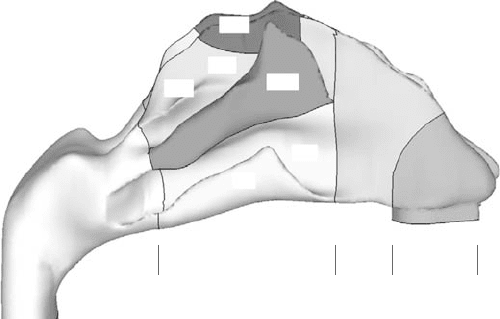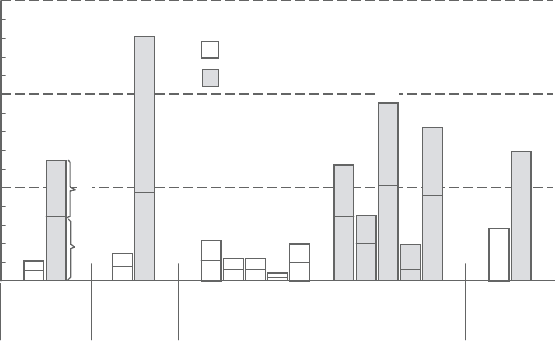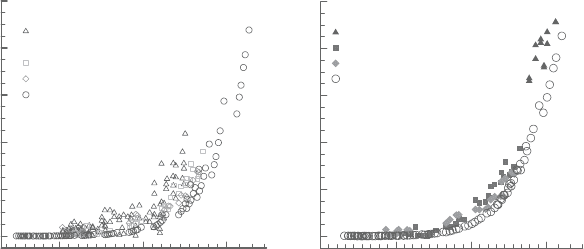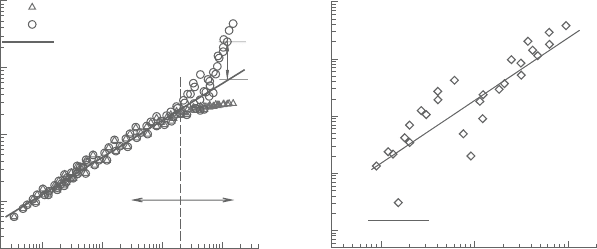Amano R.S., Sunden B. (Eds.) Computational Fluid Dynamics and Heat Transfer: Emerging Topics
Подождите немного. Документ загружается.


Sunden CH011.tex 10/9/2010 15: 22 Page 446
446 Computational Fluid Dynamics and Heat Transfer
Nasopharynx Main passage
IM
LP
MM
UP
OR
SM
Valve
region
Vestibule
Figure 11.11. Surface geometry of a MRI-based human nasal cavity. The nasal
airway was divided into different anatomical sections to exam-
ine sub-regional particle deposition. Sections include the vestibule,
nasalvalveregion,olfactoryregion(OR),septumwall(SW),middle
meatus (MM), as well as the upper (UP) and lower (LP) passages
thatincludethesuperior(SM)andinferior(IM)meatus,respectively,
and the nasopharynx.
indicating a dramatic increase of the velocity-dependent inertia effect on particle
localization. For the smaller 40nm particles, the maximum DEF value of approxi-
mately18forcyclicinhalation isonly twiceaslargeasthe steadystatevalueof8.3.
As a result, transient conditions haveagreater effect onthe deposition of a 200nm
aerosol, in comparison with 40nm particles, due to inertial effects.
Geometric complexity, turbulence, and transient floware all expected to signif-
icantly influence the deposition of aerosols in the respiratory tract [38,64–66]. In
this context, an extended DF-VC model was evaluated by comparing with exper-
imental results in a complexTB geometry with transient and laminar-to-turbulent
flows. Through comparison with the CS model, the DF-VC approach was shown
to better capture the expected effects of particle inertia on a total and local basis.
11.6.2 Nasal cavity
The DF-VC model was further tested in a human nasal airway, which was based
onMRI scansof ahealthynon-smoking 53-year-oldmale(weight 73kg andheight
173cm). The procedure for developing the nasal airway geometry and mesh is
similartotheapproachappliedfortheTBmodelintheprevioussection.Asshownin
Figure11.11,thenasalcavityischaracterizedbynarrow,convoluted,andmultilayer
channels called meatus.This complex passageway generates unique aerodynamics
insidethe nasalcavityandhelps thenose toaccomplishits physiologicalfunctions.
Conversely,reasonsfordeficientnasalfunctioncanoftenbetracedbacktoabnormal

Sunden CH011.tex 10/9/2010 15: 22 Page 447
Evaluation of continuous and discrete phase models 447
(b) DF-VC model
DE = 0.021%
DEF
DEF
DE = 0.067%
012345
012345
DEF
max
= 97 DEF
max
= 592
(a) CS model
Q
in
= 30 L/min
d
p
= 400 nm
Figure 11.12. Numerically determined deposition enhancement factors (DEF) in
the nasal airway for 400 nm particles at an inhalation flow rate of
30L/min using the (a) CS and (b) DF-VC models.
global andlocal flow conditions andturbulent phenomena inthe nasal passages. In
anadult,18,000to20,000Lofairpassthroughthenoseeachday. Besideswarming
and moistening the inhaled ambient air, the nasal cavity also houses olfactory
sensory receptors, filters out airborne pollutants, drains excess sinus secretions,
and balances pressure between the middle ear and atmosphere.
As in the previous section, two continuous field particle transport models, i.e.,
CS and DF-VC models, are considered. To highlight the effect of finite particle
inertia on deposition localization, a comparison of DEFs predicted using the CS
and DF-VCmodels are shownin Figure11.12 for400nm particles ataninhalation
flow rate of 30L/min. With DEF values plotted on the same scale, the difference
between these two models is striking. Incontrastto the more uniformly distributed
DEF values ofthe CS model,the deposition withthe DF-VC modelis significantly
moreheterogeneousand localized.Specifically, atthe anteriorjunction point(solid
circle) between the middle meatus and medial passage where high-speed flow and
steep geometry transition occur, the hot spot of the DEF value predicted by the
DF-VC model is about five times higher than the CS value. Another expected hot
spot is at the superior part of the vestibule (dashed square), which is captured
by the DF-VC model. In contrast, the CS model does not indicate this region as
having elevated deposition. Additionally, elevated deposition accumulations are
also predicted around the rear olfactory region (filled arrow) based on the DF-VC
model due to trajectory deviations of large particles from curved streamlines in
the main airflow. These elevated localizations may have important implications
in chemical sensing applications or nasal dr ug delivery for neurological disorders
where the olf actory region is the targeted deposition site.
The effectiveness of the DF-VC model incapturing inertial and diffusive depo-
sition is further illustrated in Figure 11.13 in terms of deposition within specific
sections of the nose. The definition of each section is depicted in Figure 11.11

Sunden CH011.tex 10/9/2010 15: 22 Page 448
448 Computational Fluid Dynamics and Heat Transfer
0
LP
MM
UP
OR
SW
LP
MM
SW
OR
0.015
0.01
0.005
Deposition fraction (%)
Vestibule Nasal valve
region
Main passage Nasopharynx
Right
DF-VC model
CS model
Q
in
= 30L /min, d
p
= 400 nm
Left
UP
Figure 11.13. Comparison of deposition fractions between the CS and DF-VC
models in different nasal sections.The magnitude of the deposition
fractionvaluesintheanteriorandmainnasalairwayisthesummation
of the right (lower bar) and left (upper bar) nasal passages.
and the inhalation conditions are identical to those shown in Figure 11.12
(i.e., Q
in
=30L/min and 400nm particles). The magnitude of the deposition frac-
tion value for each region (except for the nasopharynx) represents the summation
of right (lower bar) and left (upper bar) nasal passages. The deposition fraction
values for the CS model denote deposition from diffusion only, while the differ-
ence between theDF-VC and CS modelscan be viewedas deposition from inertial
impaction. In the vestibule, where the direction of airflow changes by approxi-
mately 90
◦
, significantly enhanced deposition is predicted by the DF-VC model,
which is about 6.1 times the CS model estimate for identical conditions. An even
more pronounced effect of inertial impaction (i.e., an order ofmagnitudeincrease)
is foundin the nasal valve region wherethe cross-sectional area isminimal and the
airflow passages are narrowest. In this region, the valve-associated stenosis, flow
acceleration, and short distances to the walls combine to effectively increase the
inertialdepositionofparticlesentrainedintheflow.Theinertialeffectondeposition
in the main passage remains significant, but to a lesser degree in comparison with
the vestibuleand nasal valve regions, which is likely due tothe increased flow area
(decreased flow speed) andless severe streamline curvatures.Within the main pas-
sage, diffusion is enhanced in the middle and inferior meatus by the slow-moving
flows (and the resulting prolonged particle residence times) as well as the large
surface areas of these two fin-like projections available for particle contact. As a
result, the deposition fraction of the DF-VC model is only 3.0 times that of the CS
model for the middle meatus and 2.9 times larger for the lower passage.
Figure 11.14a shows the DF-VC simulation results of inspiratory deposition
fractions in comparison to replica measurements as a function of a diffusion

Sunden CH011.tex 10/9/2010 15: 22 Page 449
Evaluation of continuous and discrete phase models 449
X
X
X
X
X
X
X
X
X
X
X
X
X
X
X
X
X
X
X
X
X
X
X
X
X
X
X
X
X
X
X
X
X
X
X
X
X
X
X
X
X
X
X
X
X
X
X
X
X
X
0
20
40
60
80
X
SLA (Kelly et al., 2004)
Viper (Kelly et al., 2004)
ANOT1 (Cheng et al., 1995)
ANOT2 (Cheng et al., 1995)
DF-VC simulation
Deposition fraction (%)
100
10
−3
10
−2
10
−1
(a) Inhalation diffusion parameter (D
1/2
Q
−1/8
)
C1 (Cheng et al., 1993)
ANOT1 (Cheng et al., 1995)
ANOT2 (Cheng et al., 1995)
DF-VC model
Deposition fraction (%)
0
20
40
60
80
100
10
−3
10
−4
10
−2
10
−1
(b) Exhalation diffusion parameter (D
0.5
Q
−0.28
)
Figure 11.14. Predicted deposition rates with the DF-VC model in comparison
with existing in vitro experimentaldata for particles ranging from 1
to 1,000nm and inhalation flow rates ranging from 4 to 45L/min:
(a) inspiratory, (b) expiratory. Units: Q [L/min] and D [cm
2
/s].
parameter suggested by Cheng et al. [67]. Inhalation flow rates that were con-
sidered included 4, 7.5, 10, 15, 20, and 30L/min with particle sizes ranging from
1 to1,000nm.The correlated association ofdeposition fraction withtheparameter
(D
1/2
Q
−1/8
) indicates a stronger dependence of nasal deposition on particle diffu-
sivity (exponent of 1/2) than on flow rate (exponent−1/8) for the submicrometer
particles considered.
Figure 11.14b shows the DF-VC simulation results of expiratory deposition
fractions in comparison with existing in vitro deposition data. Simulated expira-
tory deposition rates with the discrete Lagrangian tracking is also superimposed
in this figure, which closely matches the continuous-phase DF-VC results. From
Figure11.14b, reasonablygood agreement is observedbetween simulationsand in
vitro measurements for the three replica casts considered with slight underestima-
tiontotheinvitrodata.Specifically, thecloselycorrelatedassociationofdeposition
fraction with the parameter (D
0.5
Q
−0.28
) indicates a stronger dependence of nasal
deposition on particle diffusivity (exponent of 0.5) than on flow rate (exponent
−0.28) for the submicrometer particles considered.
Asdescribedearlier,theDF-VCapproximationaccountsforbothparticleinertia
and diffusion, whereas the CS model only considers particle diffusion.As a result,
theincreaseddepositionoftheDF-VCmodelovertheCSapproachcanbeattributed
entirely to particle inertial effects. For ultrafine particles where inertial effects
are negligible, the Sherwood number Sh is nearly identical for the two models
considered (Figure 11.15a). Deviation of Sh between the DF-VC and CS models
begins at Re
0.55
Sc
0.60
=1.5 × 10
4
(equivalently, St
k
=1.0 × 10
−5
) and becomes
progressivelysignificant withincreasing values ofRe
0.55
Sc
0.60
(orSt
k
). Compared
with the inertial limit of St
k
=5.0 × 10
−5
for TB airways [20], a smaller value in

Sunden CH011.tex 10/9/2010 15: 22 Page 450
450 Computational Fluid Dynamics and Heat Transfer
R
2
= 0.80
DSh = 4.7 × 10
6
St
k
1.1
10
0
10
1
10
2
10
3
10
4
Sherwood number deviation, ∆Sh
DSh
(a) Correlation for diffusion regime (b) Correlation for inertia-based deposition
St
k
10
−3
10
−4
10
−5
10
2
10
3
10
4
10
5
Re
0.55
Sc
0.60
Sh = (Re
0.55
Sc
0.60
)
0.553
R
2
= 0.93
CS model
DF-VC model
Correlation for diffusion
Sherwood number, Sh
10
4
10
3
10
2
10
1
Diffusion-
impaction
Diffusion
Sh deviation
Correction for inertia
Figure 11.15. Development of a Sherwood number Sh correlation in the nasal
airway that accounts for both diffusional and inertial deposition
mechanismsforsubmicrometeraerosols: (a)correlationforultrafine
particles where diffusion dominates deposition and (b) correlation
forenhancedmasstransportduetoparticleinertia,Sh,asafunction
of Stokes number, St
k
.
the nasal cavity indicates an earlier onset of particle inertial effects, which may be
due to the high complexity of this geometry.
While the nasal deposition can be reasonably predicted by existent empirical
correlations in the literature, these expressions are typically limited to ultrafine or
coarse particles where either diffusion or inertial impaction are the predominate
mechanisms for particle loss. Therefore, a correlation that is valid for both diffu-
sional and inertial deposition regimes is of value to inhalation toxicologists and
is sought in this study based on numerical experiments. Figure 11.15 shows the
development of a mass transfer correlation in the nasal cavity in terms of the non-
dimensional Sherwood number. The dependence of mass transfer on convective
diffusion is plotted in Figure 11.15a with a best-fit correlation for the diffusion
zone given by
Sh = (Re
0.55
Sc
0.60
)
0.553
= Re
0.30
Sc
0.33
(St
k
≤ 1.0 ×10
−5
) (19)
The convective–diffusion coefficient (Re
0.55
Sc
0.60
) adopted here was suggested by
Chenget al.[68] forinvivo nasaldepositiondata. Forfine respiratoryparticles that
are influenced by diffusion and impaction deposition mechanisms, the deviation
from the above equation (Sh, see Figure 11.15a) due to par ticle inertia can be
correlated as a function of St
k
using (Figure 11.15b)
Sh = 4.7 ×10
6
St
1.1
k
(20)

Sunden CH011.tex 10/9/2010 15: 22 Page 451
Evaluation of continuous and discrete phase models 451
Basedontheassumptionofweakcouplingbetweentheinertialanddiffusivedeposi-
tion mechanisms,the overallcorrelation thatis validfor allsubmicrometer particle
sizes can be obtained by adding equations (19) and (20) as:
Sh = Re
0.30
Sc
0.33
+ 4.7 ×10
6
St
1.1
k
(d
p
= 1 −1,000nm) (21)
Alternatively, the above correlation can be expressed in terms of total nasal
deposition fraction,
Df = 1 −exp
−
A
s
A
c
Re
−0.70
Sc
−0.67
+ 4.7 ×10
6
St
1.1
k
ReSc
(22)
where A
s
is the total surface area and A
c
the mean cross-sectional area of the nasal
passage.The above equation is valid for particle size ranging from 1 to 1,000nm.
11.7 Discussion
Numericalsimulationsoffinerespiratoryaerosolsarechallengingduetolowdepo-
sition efficiencies and the action of concurrent inertial and diffusive deposition
mechanisms.The CS Eulerian model that is typically applied for ultrafine aerosols
ishighlyefficientandshowsreasonableagreementwithanalyticsolutionsforultra-
fine diffusive depositionin atubulargeometr y [17,20,69]. However,the typical CS
Eulerian model neglects the effects of finite particle inertia [20,32] and cannot be
used to predict fine particles in the range of 100 to 1,000nm. As presented in this
chapter, finiteparticle inertiamaysignificantlyaffectthe totaldepositionof submi-
crometeraerosolsassmallas70nmandthelocaldepositionof particlesas smallas
40nm[25,40,42].Basedontheavailabletwo-phaseflowliterature, thestandardDF
model should adequately model the deposition of dilute fine respiratory aerosols
based on diffusional and inertial transport mechanisms [32,33]. However, results
presented by Longest and Oldham [25] and summarized above indicated a signif-
icant overprediction of respiratory aerosol deposition with the use of the standard
DF formulation.This overestimationwas duetosignificant changes in particle slip
velocity between the near-wall control volume center location and conditions at
particle-to-wall contact. To improve the simulations of submicrometer aerosols in
the respiratory tract, ahybridDF-VCmodel was developed and testedboth experi-
mentallyandnumerically [25,40,42].IncomparisonwiththeCS model,deposition
resultsoftheDF-VCapproachpersistentlyagreedbetterwithexperimentalfindings
on a total and subbranch basis, which indicated that the DF-VC model effectively
captured the influence of finite par ticle inertia. Results of this study indicate that
a DF particle transpor t model with near-wall velocity corrections can provide an
effective approach for simulating the transport and deposition of submicrometer
respiratory aerosols in complex human respiratory airways.
While theDF-VC modelhas been shownto be effective forsubmicrometer res-
piratory aerosols, it does have several limitations. The current DF-VC model was
Sunden CH011.tex 10/9/2010 15: 22 Page 452
452 Computational Fluid Dynamics and Heat Transfer
developed mainly for submicrometeraerosols based onthe use ofthe pressure gra-
dientterminequation(11b).Thismodelcanalsobeextendedtolargerparticlesizes
if equation (11a) is used to compute particle slip.Another limitation of the general
DF approach is the assumption of a dilute aerosol in which the momentum of the
discrete phase does not influence the flow field. As a result, low loadings of parti-
cle concentration are required, which is generally the case for respiratory aerosols.
Finally, the current model was developed for monodisperse aerosol distributions.
The results of the studies summarized in this chapter should not be interpreted
to imply that the continuous field DF-VC model is superior to Lagrangian parti-
cle tracking for simulating aerosol transport in all situations.A primary advantage
of Lagrangian particle tracking is the direct treatment of particles as individual
or potentially interacting discrete elements, in contrast with the approximation of
a continuous aerosol field. Treating particles as discrete elements allows for the
direct evaluation of individual force terms that represent a number of physical
phenomena such as lift, near-wall lubrication, and particle-to-particle interactions
[29]. Furthermore, Lagrangian particle tracking can be directly applied to non-
spherical shapes, like rotating fibers, and polydisperse aerosols. In contrast to the
Lagrangian approach, theDF-VCmodel approximatesfiniteparticles asacontinu-
ous species.As a result,transport anddepositionare evaluatedfrom the solutionof
aconvection–diffusionequation,whichmayintroducenumericaldissipationerrors
into the solution. Furthermore, itdoes not appear that the DF-VCmodel can effec-
tively account for particle-to-particle interactions or the motion and interception
of complex shapes, like rotating fibers.A primary advantage of the DF-VC model
is high efficiency, where successive additions of discrete particles are not required
to establish converged local deposition characteristics. As a result of these obser-
vations, it is clear that both the continuous field DF-VC model and Lagrangian
particle tracking have inherent strengths and weaknesses. Further testing and eval-
uation is required to extend the flexibility of the DF-VC model and to overcome
somecurrentlimitations,suchasmonodisperseaerosols.Itislikelythatselectionof
EulerianversusLagrangianmodelsforsubmicrometeraerosoltransportwillremain
dependent on the particular problem of interest in conjunction withtheadvantages
and disadvantages of each method. However, results of this study indicate that the
DF-VC model does provide an effective approach that can simulate the concur-
rent action of diffusion and inertia in a complex transient and laminar-to-turbulent
flow field.
Inconclusion,a continuous-phaseDF particle transport modelwith anear-wall
velocitycorrectionprovidedaneffectivesolutionforthedepositionofsubmicrome-
teraerosolsunder transientand laminar-to-turbulent flowconditions. Comparisons
withastandardCSmodelindicatedthattheDF-VCapproachwasincorporatingthe
effects of finite particle inertia in determining total and local deposition character-
istics for thecomplexTB andnasalgeometries that were considered. Comparisons
of steady and transient conditions indicated that cyclical flow decreased the total
deposition of submicrometer particles but significantly increased relative particle
localization, as indicated with the DEF parameter. Future studies are necessary
to address wall surface roughness and compliance, mucus clearance, and real-life
Sunden CH011.tex 10/9/2010 15: 22 Page 453
Evaluation of continuous and discrete phase models 453
breathing waveforms before the current DF model can be directly applied to make
dose–response and health effects predictions.
References
[1] Morawska, L., Hofmann, W., Hitchins-Loveday, J., Swanson, C., and Mengersen, K.
Experimentalstudyofthedepositionofcombustionaerosolsinthehumanrespiratory
tract, Journal of Aerosol Science, 36, pp. 939–957, 2005.
[2] Kittelson, D. B. Engines and nanoparticles: A review, Journal of Aerosol Science,
29(5–6), pp. 575–588, 1998.
[3] Bernstein, G.M.Areviewoftheinfluenceofparticlesize,puffvolume, andinhalation
patternonthedepositionofcigarettesmokeparticlesintherespiratorytract,Inhalation
Toxicology, 16, pp. 675–689, 2004.
[4] Mandell, G. L., Bennett, J. E., and Bolin, R. D. Principles and Practices of Infectious
Diseases, 6th ed., Churchhill LIvingstone, NewYork, 2004.
[5] ICRP, Human Respiratory Tract Model for Radiological Protection, Elsevier Science
Ltd., NewYork, 1994.
[6] Chan, T. L., and Lippmann, M. Experimental measurements and empirical modeling
oftheregionaldepositionofinhaledparticlesinhumans,American IndustrialHygiene
Association Journal, 41, pp. 399–409, 1980.
[7] Heyder, J., Gebhart, J., Rudolf, G., Schiller, C. F., and Stahlhofen, W. Deposition of
particles in the human respiratory tract in the size range of 0.005–15 microns, Journal
of Aerosol Science, 17(5), pp. 811–825, 1986.
[8] Stahlhofen,W., Rudolf,G.,andJames,A.C.Intercomparisonofexperimentalregional
aerosol deposition data, Journal of Aerosol Medicine, 2(3), pp. 285–308, 1989.
[9] Binkova, B., Giguere, Y., Rossner, P., Dostal, M., and Sram, R. J. The effect of
dibenzo[a,l]pyrene andbenzo[a]pyrene on human diploid lungfibroblasts:Theinduc-
tion of DNA adducts, expression of p53 and p21 WAF1 proteins and cell cycle
distribution, Mutation Research, 471, pp. 57–70, 2000.
[10] Pandya, R. J., Solomon, G., Kinner,A., and Balmes, J. R. Diesel exhaust and asthma:
Hypothesesandmolecularmechanismsofaction,Environmental Health Perspectives,
110, pp. 103–112, 2002.
[11] Balashazy, I., Hofmann, W., and Heistracher, T. Computation of local enhancement
factors for the quantification of particle deposition patterns in airway bifurcations,
Journal ofAerosol Science, 30, pp. 185–203, 1999.
[12] Bell, K. A., and Friedlander, S. K. Aerosol deposition in models of a human lung
bifurcation, Staub-Reinhaltuder Luft, 33, pp. 183–187, 1973.
[13] Longest, P. W., Vinchurkar, S., and Martonen, T. B. Transport and deposition of
respiratory aerosols in models of childhood asthma, Journal of Aerosol Science, 37,
pp. 1234–1257, 2006.
[14] Martonen,T. B., Rosati, J.A., and Isaacs, K. K. Modelingdeposition of inhaled parti-
cles, inAerosols Handbook, L. S. Ruzer & N. H. Harley, eds., CRC Press, NewYork,
pp. 113–155, 2005.
[15] Oldham, M. J., Phalen, R. F., and Heistracher, T. Computational fluid dynamic pre-
dictions and experimental results for particle deposition in an airway model, Aerosol
Science and Technology, 32(1), pp. 61–71, 2000.
Sunden CH011.tex 10/9/2010 15: 22 Page 454
454 Computational Fluid Dynamics and Heat Transfer
[16] Schlesinger, R. B., and Lippmann, M. Particle deposition in casts of the human
upper tracheobronchial tree, American Industrial Hygiene Association Journal, 33,
pp. 237–251, 1972.
[17] Zhang, Z., Kleinstreuer, C., Donohue, J. F., and Kim, C. S. Comparison of micro-
andnano-sizeparticle depositionsinahumanupperairwaymodel,Journal ofAerosol
Science, 36(2), pp. 211–233, 2005.
[18] Balashazy, I., Hofmann,W., andHeistracher,T.Localparticledepositionpatternsmay
play a key role in the development of lung cancer, Journal of Applied Physiology, 94,
pp. 1719–1725, 2003.
[19] Kimbell, J. S., Subramaniam, R. P., Gross, E. A., Schlosser, P. M., and Morgan,
K. T. Dosimetry modeling of inhaled formaldehyde: Comparisons of local flux pre-
dictions in the rat, monkey, and human nasal passages,Toxicological Sciences, 64(1),
pp. 100–110, 2001.
[20] Longest, P. W., and Xi, J. Computational investigation of particle inertia effects on
submicron aerosol deposition in the respiratory tract, Journal of Aerosol Science,
38(1), pp. 111–130, 2007.
[21] Shi, H., Kleinstreuer, C., Zhang, Z., and Kim, C. S. Nanoparticle transport and
depositioninbifurcatingtubeswithdifferentinletconditions,PhysicsofFluids, 16(7),
pp. 2199–2213, 2004.
[22] Phalen, R. F., Oldham, M. J., and Nel, A. E. Tracheobronchial particle dose consid-
erations for in vitro toxicology studies, Toxicological Sciences, 92(1), pp. 126–132,
2006.
[23] Longest,P.W., andOldham, M.J.MutualenhancementsofCFDmodelingandexperi-
mentaldata:A case study of one micrometer particle deposition in a branching airway
model, Inhalation Toxicology, 18(10), pp. 761–772, 2006.
[24] Robinson, R. J., Oldham, M. J., Clinkenbeard, R. E., and Rai, P. Experimental
and numerical smoke carcinogen deposition in a multi-generation human replica
tracheobronchialmodel,AnnalsofBiomedicalEngineering,34(3),pp.373–383,2006.
[25] Longest, P. W., and Oldham, M. J. Numerical and experimental deposition of fine
respiratory aerosols: Development of a two-phase drift flux model with near-wall
velocity corrections, Journal ofAerosol Science, 39, pp. 48–70, 2008.
[26] Hofmann, W., Golser, R., and Balashazy, I. Inspiratory deposition efficiency of ultra-
fine particles in a human airway bifurcation model,Aerosol Science andTechnology,
37(12), pp. 988–994, 2003.
[27] Ingham, D. B. Diffusion of aerosols in the entrance region of a smooth cylindrical
pipe, Journal of Aerosol Science, 22(3), pp. 253–257, 1991.
[28] Martonen, T. B., Zhang, Z., andYang,Y. Particle diffusion with entrance effects in a
smooth-walled cylinder, Journal ofAerosol Science, 27(1), pp. 139–150, 1996.
[29] Longest, P. W., Kleinstreuer, C., and Buchanan, J. R. Efficient computation of micro-
particle dynamics including wall effects, Computers & Fluids, 33(4), pp. 577–601,
2004.
[30] Longest, P. W., and Xi, J. Effectiveness of direct Lagrangian tracking models for sim-
ulatingnanoparticle deposition in the upper airways,Aerosol Science andTechnology,
41, pp. 380–397, 2007.
[31] Fernandez de laMora, J., and Rosner, D. E. Effects of inertia onthe diffusional depo-
sition of small particles to spheresand cylinders at lowReynoldsnumbers, Journal of
Fluid Mechanics, 125, pp. 379–395, 1982.
[32] Friedlander, S. K. Smoke, Dust and Haze: Fundamentals ofAerosol Dynamics, 2 ed.,
Oxford University Press, NewYork, 2000.
Sunden CH011.tex 10/9/2010 15: 22 Page 455
Evaluation of continuous and discrete phase models 455
[33] Manninen, M., Taivassalo, V., and Kallio, S. On the mixture model for multiphase
flow,VTT Publications 288,Technical Research Center of Finland, 1996.
[34] Wang, J. B., and Lai, A. C. K. A new drift-flux model for particle transport and
depositioninhumanairways,JournalofBiomechanicalEngineering,128,pp.97–105,
2006.
[35] Xi, J., Longest, P. W., and Martonen, T. B. Effects of the laryngeal jet on nano-
and microparticle transport and deposition in an approximate model of the upper
tracheobronchial airways, Journal of Applied Physiology, 104, pp. 1761–1777,
2008.
[36] Ghalichi,F.,Deng,X.,Champlain,A.D.,Douville,Y.,King,M.,andGuidoin,R.Low
Reynoldsnumberturbulencemodelingofbloodflowinarterialstenoses,Biorheology,
35(4–5), pp. 281–294, 1998.
[37] Wilcox, D. C. Turbulence Modeling for CFD, 2nd ed., DCW Industries, Inc., CA,
1998.
[38] Xi, J., and Longest, P. W. Transport and deposition of micro-aerosols in realistic
and simplified models of the oral airway, Annals of Biomedical Engineering, 35(4),
pp. 560–581, 2007.
[39] Xi, J., and Longest, P. W. Effects of oral airway geometry characteristics on the
diffusional deposition of inhaled nanoparticles, ASME Journal of Biomechanical
Engineering, 130, p. 011008, 2008.
[40] Xi, J., and Longest, P. W. Numerical predictions of submicrometer aerosol deposition
inthenasalcavity usinganoveldriftfluxapproach,International Journal ofHeat and
Mass Transfer, 51, pp. 5562–5577, 2008.
[41] Longest, P. W., and Vinchurkar, S. Validating CFD predictions of respirator y aerosol
deposition: effects of upstream transition and turbulence, Journal of Biomechanics,
40, pp. 305–316, 2007.
[42] Xi,J.,andLongest, P.W.Evaluationofadriftfluxmodelforsimulatingsubmicrometer
aerosol dynamics in human upper tracheobronchial airways, Annals of Biomedical
Engineering, 36(10), pp. 1714–1734, 2008.
[43] Crowe, C.T.,Troutt,T. R., andChung,J.N.Numericalmodelsfortwo-phaseturbulent
flows,Annual Review of Fluid Mechanics, 28, pp. 11–43, 1996.
[44] Allen, M. D., and Raabe, O. G. Slip correction measurements of spherical solid
aerosol particles in an improved Millikan apparatus,Aerosol Science andTechnology,
4, pp. 269–286, 1985.
[45] Hinds,W.C.AerosolTechnology: Properties, Behavior, and Measurement ofAirborne
Particles, Wiley, NewYork, 1999.
[46] Li, A., and Ahmadi, G. Dispersion and deposition of spherical particles from point
sourcesinaturbulentchannelflow,Aerosol Science andTechnology, 16,pp.209–226,
1992.
[47] Matida, E. A., Finlay, W. H., and Grgic, L. B. Improved numerical simulation of
aerosol deposition in an idealized mouth-throat, Journal of Aerosol Science, 35,
pp. 1–19, 2004.
[48] Lumb,A.B.Nunn’sAppliedRespiratoryPhysiology,ButterworthHeinemann,Oxford,
2000.
[49] Xi, J., and Longest, P. W. Effects of improved near-wall modeling on micro-
particle deposition inoralairwaygeometries,Proceedings of the 2007ASME Summer
Bioengineering Conference, Paper No. SBC2007–176227, Keystone, CO, 2007.
[50] Cohen, B.S., andAsgharian, B. Deposition ofultrafineparticles inthe upper airways:
An empirical analysis, Journal ofAerosol Science, 21, pp. 789–797, 1990.
